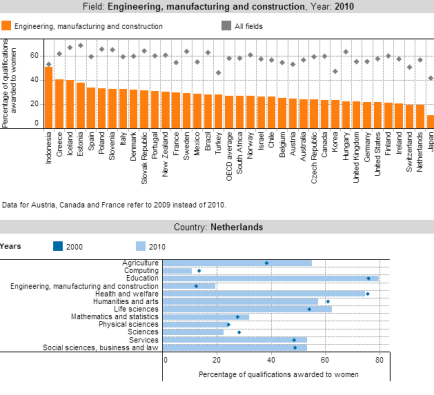Where is the female inventor?

15-year-old girls outperform boys their age heavily in reading. Boys are on average the equivalent of one school year behind in reading skills. On the other hand boys do better in mathematics, although the margin is smaller than in reading. In science 15 year-old boys and girls seem do equally well. When you dig deeper into the statistics, some large differences come to light.
Twice as much boys are among the lowest achieving students in reading. Around a quarter of the boys have the lowest proficiency level in reading, while only 12.5 percent of the girls have a proficiency level below 2. In mathematics the figures are rather different, there are far less girls that are among the top performers than boys, (10.5 percent versus 14.8 percent).

Women leave the field
Even larger differences exist between the studies girls and boys choose. In OECD countries less than 1 in 3 engineering graduates and less than 1 in 5 computer science graduates are girls. The main reason for these differences are not likely skills-based but seem a consequence of stereotypes and expectations. To break these stereotypes and to attract more women to science, CERN made a 10-point action list.
At the age of 15 far less girls, only 4.7 percent, than boys (18 percent) reported that they expect to have a career in engineering or computing. Even when girls do graduate from scientific fields of study, they are much less likely than boys to work as professional in these fields.
On the other hand, women choose more often to become a teacher in their field of expertise. Other data that solely includes OECD-countries shows that, among graduates with science degrees, 71 percent of men but only 43 percent of women work as professionals in physics, mathematics and engineering.
Healthcare more popular
Not only many women leave STEM fields, other professions are more popular among 15-year-old girls. Jordan, Thailand and Bulgaria are the countries in which careers in science or mathematics most popular. Even in these countries only between 10 percent and 20 percent of the girls sees herself as a future scientist. On average in OECD countries less than 5 percent of the girls want to study science and 18 percent of the boys.
Careers in healthcare, for example, are far more popular. In the United States, Kirghizstan, Colombia and Brazil more than a third of the young girls see themselves as a future nurse or doctor. Portugal, France and the Netherlands are the European countries where a career in healthcare is most popular, in these countries 1 in 4 girls pursues a career in this field. On average in the OECD 20 percent of the girls pursues a career in healthcare compared to just 7 percent of the boys.

Western-Europe lags behind
As a result, across OECD countries, only 13.7 percent of the inventors who filed patents are women. In countries like Korea, Japan and the Netherlands less than 10 percent of all patents are filed by women. Spain, Portugal and foremost Slovenia do a better job, in these countries around a fifth of all patents are registered by female researchers.
The percentage of patents filed by women is Slovenia has always been high, since 1980 the percentage has steadily fluctuated around the 20 percent. In the Netherlands the number has risen from 2 percent to 9 percent, in the same time. The upcoming countries Chile and Mexico are already over 16 percent, and leave the US and Western-Europe far behind.
Meest Gelezen
Vrouwen houden universiteit draaiende, maar krijgen daarvoor geen waardering
Wederom intimidatie van journalisten door universiteit, nu in Delft
Hbo-docent wil wel rolmodel zijn, maar niet eigen moreel kompas opdringen
‘Burgerschapsonderwijs moet ook verplicht worden in hbo en wo’
Raad van State: laat taaltoets nog niet gelden voor hbo-opleidingen

